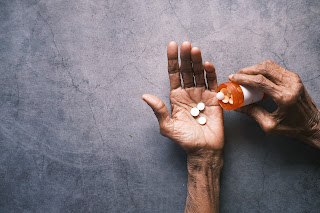What is vitamin B5? The Understanding Nutrients Series
What is pantothenic acid?
Pantothenic acid, or vitamin B5, is one of the 8 B vitamins.
It’s a water soluble vitamin, which means it dissolves in water and can’t be
stored in the body. It's not one but that's much attention but that doesn't mean it's not essential!
Roles of vitamin B5:
B5 has many key roles in our body:
Energy metabolism: all of the B vitamins are critical to
helping us convert the food we eat into energy our cells can use. But vitamin
B5 is extra special as it’s needed to make coenzyme A. Coenzyme A plays a
crucial role in in helping us convert glucose into ATP. ATP is the energy
currency our cells use, so without it we'd be pretty stuck. Vitamin B5 is also needed to help us breakdown and get
energy from fats too.
Red blood cell creation: vitamin B5 also plays a role in red
blood cell production. It helps red blood cells develop and mature, so they can
carry out their role properly.
Hormone production: hormones act as chemical messengers
around the body, signalling for things to occur. Vitamin B5 helps the creation
of fat based hormones like testosterone and oestrogen. These are essential sex
hormones that play a role in puberty, fertility, and aging. Other fat based
hormones vitamin B5 helps produce are stress hormones like cortisol.
Vitamin B5 plays many other roles in the body such as
helping to keep skin hydrated, so it’s often used in skincare products.
How much vitamin B5 do we need?
Vitamin B5 isn’t like the other nutrients that has a specific
amount that we need daily. Instead, it’s thought that between 3-7mg a day is
sufficient to meet people’s needs.
It’s absorbed in our small intestine, and about 50% of what
we eat is able to be used by the body.
What foods contain vitamin B5?
Meat, fish, grains, and some vegetables are sources of
vitamin B5. This isn’t a complete list, but to give you an idea.
- 100g chicken breast – 1.6mg
- 80g of white mushrooms – 1.9mg
- 100g avocado 1.34mg
- 100g of salmon – 1.19mg
- 50g of porridge oats – 0.37mg
- 100g of sweet potato – 0.53mg
- 100g of brown lentils - 0.33mg
- 50g of cheddar cheese - 0.25mg
What happens if you don’t get enough B5?
You should be able to get all the vitamin B5 you need from a
healthy balanced diet, and a deficiency is rare. However, deficiency can occur
if you’re severely malnourished. It also tends to occur alongside other
nutrient deficiencies too.
Symptoms can include: numbness and tingling in your hands and feet, headaches, tiredness, restlessness, trouble sleeping, and nausea/vomiting. It’s treated with supplementation.
Pantothenic acid is a nutrient that doesn’t get much press,
but without it, you wouldn’t be able to use food for energy so it’s pretty
important!
You can see all the other nutrients I’ve covered here.
Key points:
- Vitamin B5, or pantothenic acid, is a water soluble B vitamin.
- Vitamin B5 has many roles including: helping us get energy from food, creating red blood cells, and creating hormones.
- Adults need 3-7mg of B5 a day, and you should be able to get all you need from your diet.
- Good sources of vitamin B5 are: meat, dairy, grains, and some vegetables.
- A deficiency in B5 is rare, but can lead to symptoms like headaches, tingling hands and feet, and nausea and vomiting.
I hope you enjoyed this post.
Bye for now 👋
References:
https://nap.nationalacademies.org/read/6015/chapter/12#361
https://ods.od.nih.gov/factsheets/PantothenicAcid-HealthProfessional/
https://quadram.ac.uk/UKfoodcomposition/
https://www.kcl.ac.uk/open-global/biomarkers/vitamin/vitamin-b5
.jpg)



.jpg)

Comments
Post a Comment